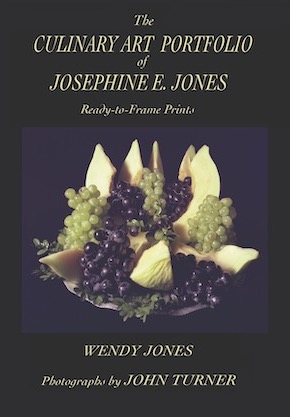Book Review: The Culinary Art Portfolio of Josephine E. Jones
Reviewed by:
Carol TaylorThe Culinary Art Portfolio is neither a cookbook nor a how-to-book. It’s a portfolio, with ready- to-frame prints of the culinary art created by Josephine E. Jones with photography by the late John Turner, written by her daughter Wendy Jones.
Introduced as “where art and food intersect” Jones writes, “For years, people took snapshots of Josephine’s food before devouring it, declaring that it ‘looked too good to eat.’”… “I cannot tell you how Josephine did what she did. I can only describe it. My mother did not take a class, read a book, or make sketches of what she wanted to do before she did it. I never saw Josephine practice her cutting technique before she put a piece of fruit or vegetable on a creation.” … “I think she visualized the culinary creation, and then cut, carved, and placed all the components where they needed to be to complete that vision.” … “My mother lived her life that way too, envisioning what she wanted to accomplish, despite the obstacles of racial, gender, and class discrimination, then taking the steps to complete her vision.”
You’ll find within the book the “process” for putting together: Not-A-Cake Sandwich Loaf, Fruit Bowl, Ham with Chaudfroid Sauce and Rice, Apple Birds, Gelatin and Cake, Vegetable Salad Fixings, Shrimp with Dipping Sauce, Pineapple with Honeydew and Watermelon, Sandwiches and Vegetables, and Crenshaw Melon, among others. Although there is information about the ingredients used in each dish, and the process, there are no quantities or amounts of the ingredients. There are, however, charming anecdotes by Jones as to how her mother made them, which give a peek into their life at that time. In this regard, they are less recipes than vignettes that illustrate how Josephine turned her work into art, and used the process, at times, as a lesson about life for her daughter.
Fruit Bowl:
“Similar to flower arranging, Josephine pays attention to the shape and color of each fruit to make this arrangement. The walnuts and grape shears draw the eye to the apples, which are the focal point of the fruit bowl. The grapes hang down, leading the eye to the lower arrangement, which may be the result of having too much fruit for the bowl, but my mother ensures it does not go to waste.
During my childhood, this fruit bowl sat in the center of our dining room table, where I spread out my books to do my homework. My mother always said, ‘Centerpieces should be edible.’ I would grab an apple, crunching its tart juiciness before tackling math, my weakest subject.
I also think the strategic placement of this fruit bowl was Josephine’s way of encouraging my studying by ensuring that I had nutritious food readily available to nourish my brain. She repeatedly passed on the advice that her father had given her:
‘Get a good education. They can’t take that away from you.’
My mother added her own advice to my grandfather’s:
‘Decide what you want to do and work hard at it. There are a lot of free things. The Y has activities, the library… you have to read a lot. One of the most important things in life is reading. You have to keep on reading and create what you want. You get visions.’”
The book is oversized, and the 16 full-color photographs are in a binder spine with perforated pages to facilitate framing. These are not contemporary photos, and as such have a charming throwback quality to them. They were taken in 1975 by the late John Turner when he was the professional photographer for Standard Brands, where Josephine worked. This was the Fortune 500 company that made Chase & Sanborn Coffee, Royal Gelatin, and Planters Peanuts. The company is now Kraft. The author includes in the Introduction, the Origins of the Culinary Art Photos, where she explains the genesis of the photographs and the collaboration. And it’s quite an interesting origin story.
“On April 17, 1975, the Center for Science in the Public Interest—and other organizations promoting nutritious food—designated the day as the first National Food Day. To celebrate the day, Standard Brands asked Ms. Jones—the supervisor of the employees’ cafeteria—to create culinary art for a photographic display. Once the photographs were removed, the company gave the negatives to Josephine.” In 1977, the employees’ cafeteria moved from the 10th floor to the 11th floor, and the photographs were used to decorate the new cafeteria.
More than a collection of fine art food photography, it is a memento and a love letter from Jones to her mother. Josephine E. Jones was ahead of her time. “The daughter of a South Carolina sharecropping family, she came to New York City in 1946 with a high school diploma and a gift for cooking.” She began as a cook in private homes, then in 1953 she filled a two-week vacancy at Standard Brands, and ended up staying for 31 years, becoming the supervisor of the employees’ cafeteria in 1967. Jones was also a Harlem activist, who helped restore their formerly “drug-saturated” block. Alongside Michael Henry Adams, the architectural historian, she helped to preserve Harlem’s historic buildings, including the 1887 family brownstone. When her marriage ended, Jones worked three jobs to send her daughter, Wendy to the Dalton School, Yale University, and Columbia University.
As Jones writes about the dish, Crenshaw Melon, “The joy of creation evident here energizes me as I dive into my writing. Similar to the fruit bowl on the dining room table when I was a student, my mother’s artistry is once again inspiring me.”
Josephine E. Jones was an extraordinary woman whose professional and personal contributions framed and shaped her daughter’s life, and who should be celebrated for the artist, activist, and change maker she was.

